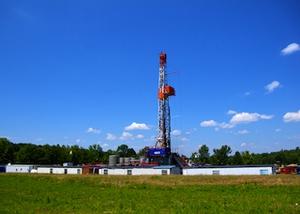WaterFarmers upset by plan for water banking system
Depending on the depth of the drilling, it can take anywhere from two gallons to two million gallons of water to frack one well; drilling companies consumeenough water in their fracking operations to meet the needs of between 66,400 and 118,000 households; in the parched Midwest, farmers raise questions about water-use priorities

In some areas, frackers and farmers compete for water supply // Source: foodandwaterwatch.org
As the drought continues to hit most of the Midwestern states, water is only getting harder to come by, and in Kansas,where 102 counties are under a federal disaster declaration, farmers are having trouble finding water for their crops.
So it is no surprise that farmers are not happy with oil and gas drillers who are moving in the state and reviving the Kansas’sdormant energy industry. Thanks to advances in technology — largely the advent of horizontal hydraulic fracturing, or fracking — drillers are able to tap oil reserves once thought to be unreachable.
The new technique, however,requires water, lots of it. Farmers in the area,including Tom Giessel, a local farmer who is also a trained geologist,are concerned about the long-term impact of drillers on water supplies. Giessel worries that under a new state water banking system, small-time farmers in need of extra water won’t be able to compete with deep-pocketed energy companies.
“Water’s going to flow towards the money,” Giessel toldGoverning.com
Governing reports that under the state’s still developing water-banking system, water rights holders can bank their reserves and sell them to the highest bidder. State regulators say the change will help move water where it is most needed.
For well resourced farmers or municipalities, it means they can make some extra cash selling off their excess water, but Giessel thinks that water shouldn’t be sold for profit.
“I think water’s one of those things that should be not-for-profit,” he says. “But I’m a different duck than some of the others.”
In much of the west, water supplies have been shrinking over a long time due to climate change and population expansion. Jason Bane of the nonprofit Western Resources Advocates (WRA) calls this year’s combination of a drought along with a rise in drilling the perfect storm. “[Drought] is changing the way people are looking at things,” Bane said to Governing.com, as the WRA is advocating for more study of fracking’s effect on available water.
Fracking affect on water
Right now there is little evidence as to how exactly fracking strains water supplies. “It all is, at this point, pretty much anecdotal,” says Tony Willardson, executive director of the Western States Water Council (WSWC).
What is known about fracking is this: Depending on the depth of the drilling, it can take anywhere from two gallons to two million gallons of water to frack one well. The numbers are staggering, but most energy companies use the numbers to compare their consumption to that of the heaviest users.
Environmentalists see the issue differently. Earlier this year the WRA released a report estimating that drilling companies were consuming enough water to meet the needs of between 66,400 and 118,000 households.
The energy industry is looking into ways to reduce water and improve treatment and recycling, but they are not close to a viable solution and each new well the means more water consumption and the increasing of the industries water footprint.
Groundwater is main source — for now
In most states where frequent drilling occurs, water officials say that fracking is not a problem in the short term. Though many states, particularly in the west, are seeing rivers and streams shrink to low levels, most drillers are not relying on those waters.
In Kansas the department of agriculture would notgrant water rights on those impaired waters, to drilling companies or anyone else for that matter. As a result drilling companies are shifting towards ground water, which is plentiful enough, for now.
In Colorado, Oklahoma,and Texas, regulators say they have seen few issues between drilling companies and rights holders downstream because few drillers are drawing from rivers and streams.
Things are different in the eastern United States as although some states such as Pennsylvania have not been hit as hard by drought, drilling companies are more reliant on small rivers and streams that respond more quickly to the weather. As a result some drillers have had their water rights suspended.
In July the Susquehanna River Basin Commission a federal-state entity that regulates water in the 27,000 square mile watershed touching Pennsylvania, Maryland,and New York, announced it had temporarily revoked sixty-fourwithdrawal permits, most of which belonged to oil and gas developers.
The number of suspensions, which can change quickly based upon rainfall, has since hovered in the 30s and 40s. Susan Obleski, the commission’s spokesperson, says permit suspensions have increased this year. Since 2008 most permit suspensions have been associated with increased drilling.
